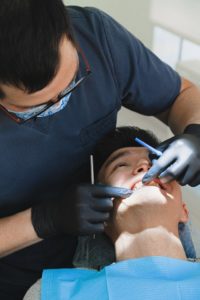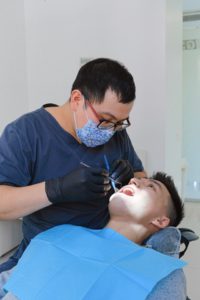 Patients with artificial joints: do they need antibiotic cover for dental treatment? This subject has been a topic for debate by both orthopaedic and dental professionals. Orthopaedic surgeons believe that it is recommended to prescribe prophylactic antibiotics while dental fraternity are less convinced. Not much clinical evidence in the field has been reported but merely this tradition is based on anecdotal evidence, historical evidence, and legal precedent.
Patients with artificial joints: do they need antibiotic cover for dental treatment? This subject has been a topic for debate by both orthopaedic and dental professionals. Orthopaedic surgeons believe that it is recommended to prescribe prophylactic antibiotics while dental fraternity are less convinced. Not much clinical evidence in the field has been reported but merely this tradition is based on anecdotal evidence, historical evidence, and legal precedent.
There have been occasional reports of joint infection linked to oral illness or therapy, according to anecdotal evidence. Focal infection hypothesis, which was popular around the 90s, claimed that many illnesses were caused by foci of infection within limited parts of the body, resulting in systemic illness.
The possible infection originates from the oral cavity that resulted from an invasive dental procedure can enter into the bloodstream and is deposited in other areas in the body, in this case the prosthetic joint. This is later thought to turn into prosthetic joint infection. The legal action stems from the warning that come with most orthopaedic implants companies, stating that antibiotics may be administered to individuals receiving the implant for all dental treatment. This general advice is given for a variety of reasons, including commercial and legal considerations. However, like all traditions in health, these need to be subject to evidence-based risk benefit analysis to test whether in fact they are true.
Clinical studies have shown that the standard management approach of covering all dental treatments for patients with artificial joints with antibiotics is not always justified and, in fact, could be detrimental. Traditional beliefs and health practices, on the other hand, are never simple to change. The overuse of antibiotics in medical and dentistry practice is a recent classic example. Although all doctors understand that an upper respiratory tract infection is caused by a virus, more than half of them will still prescribe antibiotics. Although most dentists understand that pain without localising clinical and radiographic indications is not caused by bacteria, many will nonetheless prescribe antibiotics as a precaution.
Antibiotics are unsuitable under such circumstances, according to many medical and dental practitioners, but they are prescribed regardless because the patient “demanded antibiotics.” Intensive public and health professional education programmes are now only demonstrating their effectiveness. Antibiotics are no longer the be-all and end-all for some patients, and the number of antibiotic prescriptions has plateaued. This, on the other hand, has taken a significant amount of time and work, and there is still a long way to go.
 Before joint replacement, dental care should be aggressive in order to eradicate present infection foci. If restorative, endodontic, or periodontal treatment fails to correct the problem quickly, the affected teeth should be removed. If the patients have been rendered dentally fit prior to the procedure, dental therapy is usually not required in the initial phase following the insertion of the joint prosthesis. During the first three months after receiving a prosthetic joint, patients are usually still adjusting to the new joint and are not mobile enough to attend any dental appointment. If a dental infection develops during this time, it should be treated as soon as possible with appropriate emergency treatment.
Before joint replacement, dental care should be aggressive in order to eradicate present infection foci. If restorative, endodontic, or periodontal treatment fails to correct the problem quickly, the affected teeth should be removed. If the patients have been rendered dentally fit prior to the procedure, dental therapy is usually not required in the initial phase following the insertion of the joint prosthesis. During the first three months after receiving a prosthetic joint, patients are usually still adjusting to the new joint and are not mobile enough to attend any dental appointment. If a dental infection develops during this time, it should be treated as soon as possible with appropriate emergency treatment.
In the absence of extensive periodontal disease, conventional dental treatment, including extractions, does not require antibiotics prophylaxis once a joint prosthesis is established and operating well. In high risk cases for prosthetic joint infection, the orthopaedic surgeon should discuss the case and recommend antibiotics prophylaxis if necessary. In such cases shared decision-making between the two surgeons is needed.
Recent National institute for health and care excellence (NICE) guidelines published do not recommend antibiotic prophylaxis for patient with prosthetic joint replacement who undergo invasive dental procedure. It is also important for patient to be aware of the current practice. Both the dental surgeon and orthopaedic surgeon are responsible in educating the patient and practice based on the current evidence. In that instance, the particular nature of the tooth condition and the treatment requirements must be carefully assessed. The next step is to consult with the patient’s orthopaedic physician to establish the exact risk-benefit situation.
Dr Aws Hashim Ali Al-Kadhim, Dr Azlan Jaafar and Dr Norazura Ahmad Tarmidzi are researchers and clinical lecturers at Faculty of Dentistry, Univeristi Sains Islam Malaysia
